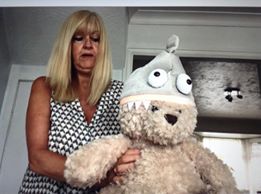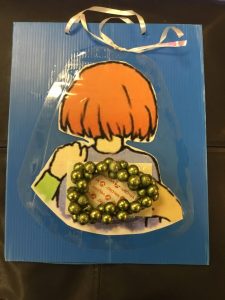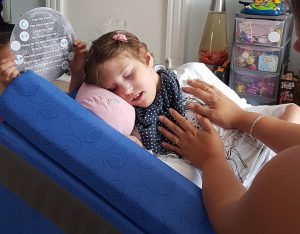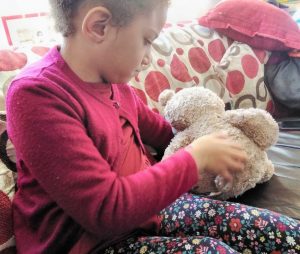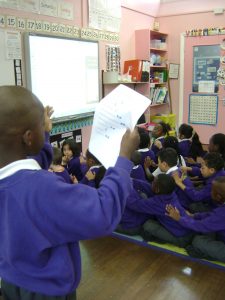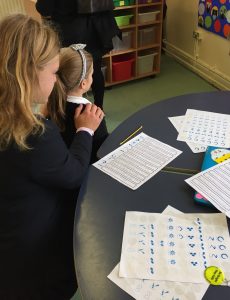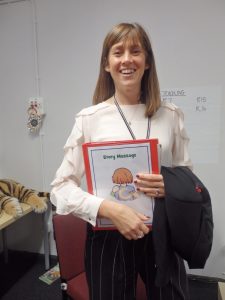Seeking consent to touch is an integral part of the Story Massage Programme. For many schools, colleges and families, the programme has become a valuable way of teaching appropriate touch and the importance of saying a confident ‘no’ to unwanted touch. We look at just a few examples of good practice with children and young people of all ages and abilities.
Discussions around consent to touch
Story Massage sessions often begin with a conversation around the importance of respectful touch and seeking consent. This video clip from Thorntree School in Glasgow shows the teacher explaining that every person’s body belongs to them, and every person has the right to make decisions about who gets to touch their body, when they are touched, and how they are touched.
Using props to open a conversation
Some Story Massage practitioners use props such as puppets or toys to model behaviour and introduce each Story Massage session. They may include information about what is happening, why and when – with opportunities for questions. This then allows individuals to give an informed choice on the day.
As part of the introduction, an adult may ask a teddy bear, for example, permission to touch. Sometimes the answer will be ‘yes’ and sometimes ‘no’. Children can be asked to look at the bear’s body language to see any clues to whether or not it wants a massage. This opens an important discussion around consent to touch and affirms that it is okay to say ‘no’.
“I was really pleased when my 6 year old daughter objected to a shop assistant who patted her on the head. She felt very uncomfortable and told him that he shouldn’t do so without first asking. She is shy with strangers and would not have had the courage to speak up without having practiced it in Story Massage sessions.”
Seeking verbal consent to touch
For those children and young people who can communicate verbally then permission can be asked for and given through words. This short video shows a few examples of verbal consent in a mainstream school, special school and family home.
Gaining non-verbal consent to touch
When children are not able to respond verbally then Story Massage practitioners seek other ways of gaining consent such as visual, tactile, sound or aroma cues. Using interpersonal skills and knowledge of the individual they can then assess a negative or positive response through facial expressions, body language, gestures, vocalisations and other non-verbal communication. Watch how Bella gives consent in this short video clip taken at Ty Gwyn Special School in Cardiff.
“The challenge, of course, is that we may interpret non-verbal communication in very different ways. Always take advice and guidance from others and try to get to know the person you are supporting as best as is possible. It is so important to welcome the expression of all emotions and that choices are continually observed and these are monitored.”
Sensory needs of each individual
Story Massage practitioners use a wide range of ways of seeking consent depending on the sensory needs of the individual. These include rubbing hands together, signing, props, specific sounds, gentle music, introduction songs and relaxing aromas that can be associated with the start of a Story Massage session. Many also use objects of reference such as this one from Springfield Special School in Crewe. It is a laminated photo of The Circle stroke with a chunky beaded bracelet superglued to it. This means that pupils with PMLD can see and ‘feel’ it.
“The Story Massage Programme is part of our Life Skills curriculum for young adults with complex needs. Sharing massage stories has increased their knowledge of positive touch and empowered them to differentiate between touch that feels safe and touch that does not feel safe. They are now able to say a confident ‘no’ or ‘yes’ in front of their peers in class. And this is being transferred to other situations too.”
Feedback during a Story Massage session
Children and young people are also taught they have the choice of where they are touched and how they are touched. They are encouraged to indicate if they want the pressure to be lighter or firmer to suit their sensory needs, or if they want the massage to stop. And, of course, if they are enjoying it and want more! Again, this may be through verbal or non-verbal communication. The person giving the massage, whether peer or an adult, listens to the feedback and responds appropriately.
“Some students indicate they prefer their thighs massaged, others the chest or abdomen and another always holds her hand out for the strokes to be contained on her palm or back of her hand. A student who is congenitally blind leads the adult’s hands under hers indicating the pressure she desires. When the massage finishes students often vocalise or sign to indicate more – it’s rare they have a chance to be asked.”
This video clip shows a demonstration of an Aided Learning Display created at Springside School in Rochdale to give pupils the opportunity to tailor the massage to their individual needs on the day.
Respectful touch for all
In some instances, the child or young people may not understand the choice that is being given. Story Massage practitioners always show respect by taking time to know the individual, addressing them individual by their name, asking permission with good eye contact, reassurance and a gentle tone of voice. Then they may gradually introduce touch by holding hands, gently resting hands on shoulders, arms or knees or doing a simple massage stroke. They can take it very gradually, watching closely for any response and decide whether or not to continue with the massage story. This is repeated on every occasion.
“An individual may not be able to communicate in traditional ways, but they have the right to say ‘yes’ or ‘no’. It is so important to give the individual sufficient time to process what is being asked and to communicate their wishes. My daughter usually loves Story Massage but some days her body language show she clearly doesn’t want it.”
It’s okay to say ‘no’ to touch
When a child or young person declines touch, whether through verbal or non-verbal communication, then the massage is always stopped. Many initially hesitant individuals do eventually choose to take part, but this is always their own decision made in their own time. And some may indicate ‘yes’ on one day, and ‘no’ on another.
“As Story Massage practitioners we don’t rely solely on ‘a yes’ answer. Some children mask their feelings and find it difficult to say ‘no’. So, in addition to gaining consent, we monitor body language throughout. In a peer massage situation, we are mindful of taking care to keep checking in with all those who are participating.”
It is also important to consider why a child or young person is saying ‘no’ to touch. Is it because they do not like the touch? Or they have never experienced positive touch? Or they may have experienced it and love it but at that moment just not want to take part. Or are they feeling a bit anxious about what will happen?
“A child at our nursery chose to do the massage story on the class teddy at first. Then he used the teddy’s paws to massage a peer. And then he invited his peer to use the teddy’s paws to massage him. Eventually, he progressed to using his own hands to give and receive a massage story.”
Those who do not want to be touched are gently encouraged to be included in the Story Massage activity, in their own way, and share the benefits. For example, they may do the massage on themselves, a teddy or an adult. Or they could do the strokes in the air, on the floor, on a wall or an invisible person in front of them.
Some children gain confidence and trust by being given a role within the the activity. For example they may check everyone in the group is happy and enjoying the massage, take charge of operating the powerpoint presentation or recording, or assist the session leader by holding up the massage story and demonstrating the strokes in the air.
Gaining consent from older people
Whilst this blog has focussed on issues around consent to touch for children and young people, all the information is relevant for adults especially in situations where their preferences may not be easily understood.
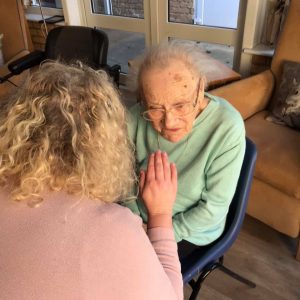
“The Story Massage Programme is of great benefit to people with dementia and also young adults with complex needs living in care settings. So much personal contact is carried out routinely it is important to allow an individual to indicate a choice of ‘no’ or ‘yes’ to receiving a massage story.”
Saying ‘thank you’
At the end of the massage story, the person giving the massage says ‘thank you’ to the person receiving the massage as a mark of respect and gratitude. The appreciation is usually reciprocated! This short video clip shows this in action.
More about the Story Massage Programme
The Story Massage Programme combines the benefits of positive, respectful touch with the creativity and engagement of storytelling. Ten simple massage strokes form the basis of the programme. These strokes have a name, such as The Circle or The Sprinkle, an action and an easy to recognise symbol. It is a fully inclusive activity, no clothing is removed and no oil is used.
Would you like to train in Story Massage?
Would you like to learn more? Sign up for our Story Massage Online Course and help share the benefits with the children or adults in your care – at home or at work.
We teach you how to share the ten Story Massage strokes and work with you to adapt familiar stories and even create some sensory stories of your own. Ideal for teachers, SEN staff, support staff, therapists, Early Years practitioners, those working with people with additional needs, Baby Massage Instructors, Relax Kids Coaches… everyone with an interest in sharing positive touch activities with children and adults.

